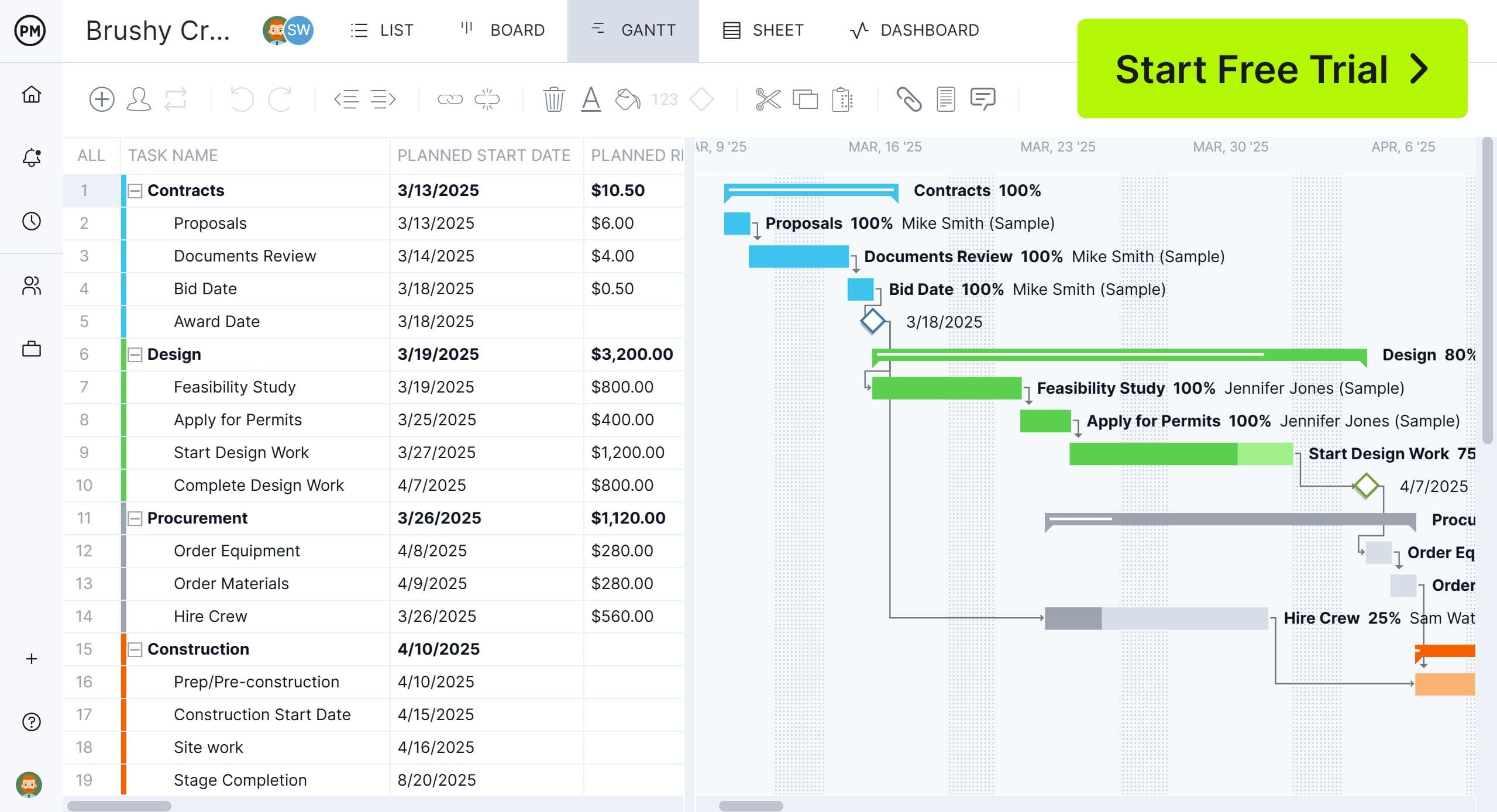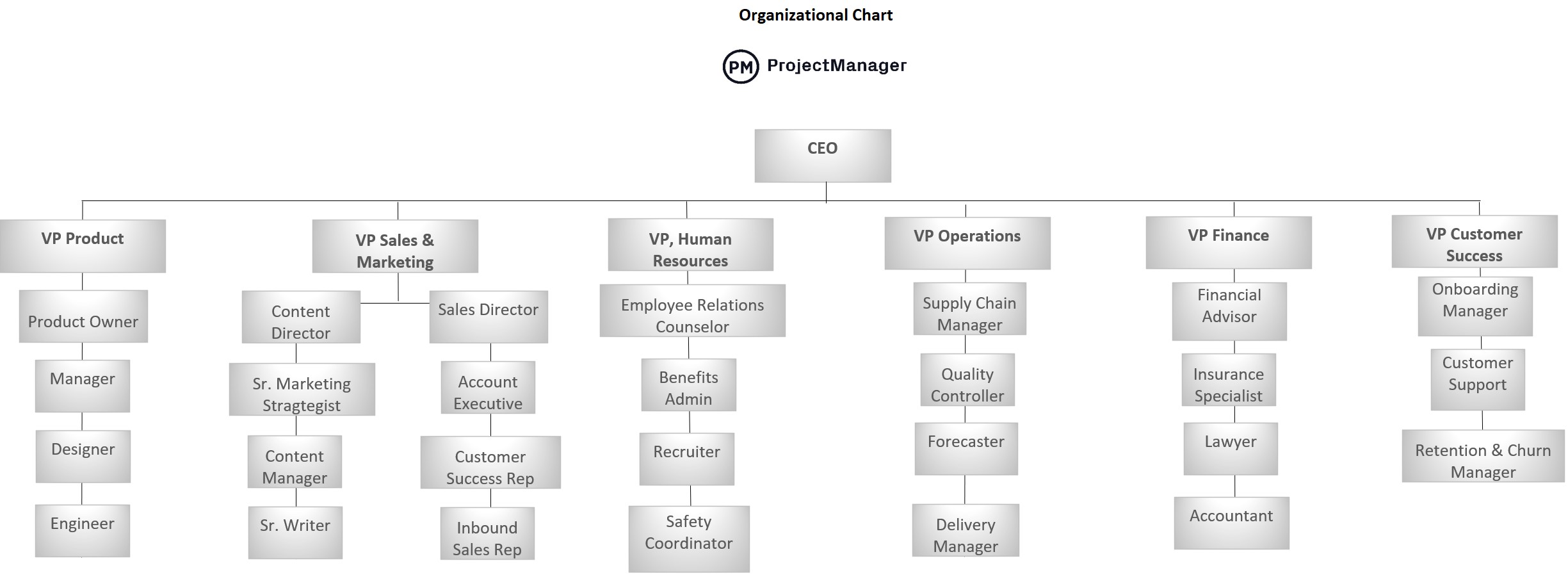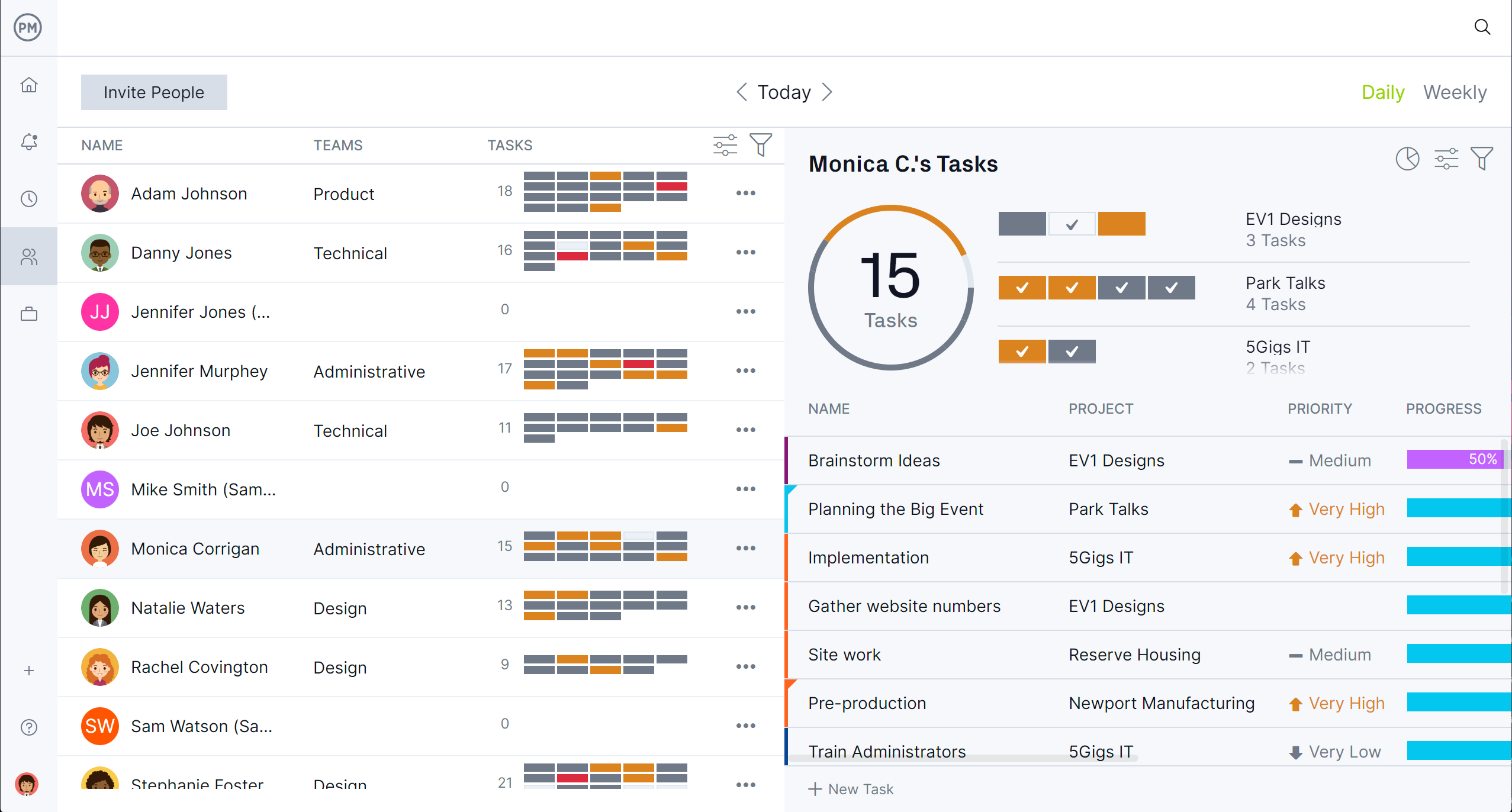Creating a construction company organizational chart is one of the most effective ways to visualize how your business operates. Whether you run a small local contractor or a large general construction firm, having a clear picture of the roles and reporting structure keeps everyone aligned. An organizational chart for construction company use helps clarify who is responsible for what and how information flows across departments. This makes collaboration smoother and reduces confusion on job sites.
A construction company organizational chart also supports better planning and growth. As your business takes on larger or more complex projects, your construction company organizational structure needs to scale with you. By mapping out the hierarchy and relationships between owners, project managers, site supervisors and crews, you create a system that supports accountability and efficiency. The right chart helps new hires quickly understand your processes and ensures every project stays organized from planning to completion.

Get your free
Organizational Chart Template
Use this free Organizational Chart Template for Excel to manage your projects better.
What Is a Construction Company Organizational Structure?
A construction company organizational structure defines how roles, responsibilities and reporting relationships are arranged within a construction business. It outlines how owners, project managers, foremen, tradespeople and office staff interact to deliver projects. Having a well-thought-out construction company organizational structure is critical for managing workflows, avoiding confusion and ensuring each phase of a project runs smoothly.
The organizational structure of construction company operations can vary based on size and specialty. A small construction company organizational structure might be flat, with a few key decision-makers overseeing multiple functions, while a larger contractor uses a more hierarchical structure with department heads and dedicated project teams. Whatever the size, the goal is to clarify authority, improve communication and support efficiency across every job site.
Project management software helps construction businesses create, visualize and refine their construction company organizational chart. It gives leaders a way to assign tasks, track dependencies and map out workflows that match the real-world structure of their teams. These tools make it easier to manage resources, document processes and ensure accountability, which is essential when multiple subcontractors and crews are involved.
ProjectManager is a top choice for construction companies looking to streamline their operations and manage their construction company organizational structure more effectively. It offers multiple project views, including Gantt, board and calendar, real-time dashboards to track progress, and robust resource management features that help balance workloads. Construction teams can schedule tasks, manage costs, collaborate on files and monitor project health in one platform, making our software a practical solution for keeping projects organized and on schedule. Get started with ProjectManager today for free.

What Is a Construction Company Organizational Chart?
A construction company organizational chart is a visual representation of how roles, teams and reporting relationships are structured within a construction business. It shows who oversees which departments, how communication flows between management, project teams and field workers, and where decision-making authority lies. This makes it easier for everyone in the company to understand responsibilities and collaborate effectively.
Having an organizational chart for construction company operations also helps leaders plan staffing, allocate resources and manage project workloads. It reduces confusion on job sites by clarifying who is accountable for scheduling, budgets and quality control. Whether it’s for a small construction company, organizational structure or a large general contractor, this chart serves as a blueprint for keeping teams aligned and projects running smoothly.
What Roles Are Typically Included in a Construction Company Organizational Chart?
A construction company organizational chart typically includes all the key roles that keep projects moving from planning to completion. This chart often starts with company leadership, then shows department heads, project managers and field supervisors who direct daily operations. It also highlights supporting teams such as estimators, schedulers, accountants and safety officers who ensure projects stay on budget, on time and in compliance. Including these roles gives a clear picture of how responsibilities are divided and who reports to whom across the organization.
Executive & Corporate Level
At the top of the chart are executive leaders who guide strategy, ensure profitability and oversee company health. The CEO or president defines long-term vision, while vice presidents often specialize in key functions like operations or business development. A CFO manages finances, and a COO ensures smooth daily operations. These roles aren’t involved in day-to-day construction but provide critical resources, decision-making authority and corporate governance that allow the company to secure projects, maintain credibility and grow sustainably.
- Owner/CEO/President: Provides strategic vision, sets company goals and represents the firm at the highest level.
- Vice President(s): Oversees specific divisions such as operations, finance or business development.
- Chief Financial Officer (CFO): Manages budgets, financial reporting and ensures fiscal health.
- Chief Operating Officer (COO): Handles daily business operations and ensures smooth organizational performance.

Operations & Project Management
This tier focuses on executing projects. Project directors oversee multiple large jobs, while project managers handle individual contracts, balancing schedules, budgets and teams. Assistant project managers and engineers support documentation, coordination and technical problem-solving.
On site, superintendents or site managers control daily activities, and foremen supervise trades directly. Together, these roles create a bridge between corporate strategy and field execution, ensuring construction progresses according to plans while adapting quickly to challenges that arise in the field.
- Project Director/Senior Project Manager: Supervises several large projects and ensures alignment with company objectives.
- Project Manager: Manages day-to-day project delivery, including scope, budget and schedule.
- Assistant Project Manager/Project Engineer: Provides administrative and technical support to project managers.
- Superintendent/Site Manager: Oversees on-site operations, safety and coordination of subcontractors.
- Foreman: Directly supervises trade workers, ensuring tasks are completed to standards and deadlines.
Specialized Departments
Specialized functions strengthen efficiency, safety and quality. Estimators prepare bids, while preconstruction managers align design and budgets before work starts. Scheduling managers produce timelines, procurement staff secure materials and subcontractors, and safety officers enforce health and safety compliance.
Quality control teams manage inspections and standards, while contracts administrators oversee subcontracts and documentation. These positions provide expertise that project managers depend on, creating consistency and accountability across multiple projects while ensuring each job meets cost, schedule and compliance goals.
- Estimating Team: Prepares detailed bids and cost analyses to win projects profitably.
- Preconstruction Manager: Coordinates design, budgeting and planning before construction begins.
- Scheduling Manager/Planner: Develops and maintains project timelines to track progress.
- Procurement/Purchasing Manager: Sources materials and negotiates supplier contracts.
- Safety Manager/Officer: Ensures compliance with regulations and promotes a safe work environment.
- Quality Control/Quality Assurance Manager: Oversees inspections and enforces quality standards.
- Contracts Administrator: Manages subcontracts, legal documentation and compliance requirements.
Related: 10 Best Construction Project Management Software
Technical & Field Staff
Field and technical staff deliver the work on-site. Site and field engineers provide technical layouts and resolve design issues. Surveyors ensure precision in measurements. Skilled trades like carpenters, electricians, plumbers and masons apply their expertise to specialized tasks, while equipment operators manage cranes, bulldozers and other machinery. General laborers handle supporting duties across the site. This group is the largest in a construction company, translating drawings into physical structures and keeping day-to-day work progressing safely and productively.
- Site Engineers/Field Engineers: Provide technical guidance and ensure design accuracy on site.
- Surveyors: Measure land and layout building elements with precision.
- Trades & Skilled Workers: Execute specialized work such as carpentry, electrical, plumbing and masonry.
- Equipment Operators: Operate heavy machinery essential for excavation, lifting and material handling.
- General Laborers: Support skilled trades by assisting with diverse construction tasks.
Related: 32 Construction Documents (Templates Included)
Support Functions
Support roles allow the business to function beyond construction sites. HR manages hiring, training and employee relations. IT specialists maintain project management software and company systems. Administrative staff coordinate paperwork, schedules and communication between teams. Business development and marketing professionals build client relationships and secure new projects. Though not directly tied to construction, these functions are critical for ensuring the workforce, technology and brand reputation are strong, keeping the company competitive and projects adequately supported.
- Human Resources Manager: Recruits, trains, and manages workforce needs.
- IT & Systems Support: Maintains digital systems, software and communication platforms.
- Administrative Staff: Handles paperwork, schedules and office coordination.
- Business Development/Marketing: Secures new projects, nurtures client relationships and promotes services.
Free Organizational Chart Template
Download this free organizational chart template for Excel for visualizing your company’s hierarchy. Designed as a tree diagram, it places the CEO or top leader at the apex, with branches extending down to departments, teams and individual roles.

This layout provides clarity on reporting lines and team structures, which is especially beneficial for growing businesses or those with complex organizational frameworks. Users can personalize the chart by adding company logos, contact details and even employee photos, making it both functional and visually engaging.
Construction Company Organizational Chart Example
A construction company organization chart is meant to be seen, not written about. Therefore, we took the above roles and added them to a tree diagram to illustrate how it would look in the format that it would be created and shared in.

With the list of roles and definitions above, and the illustration of what that organization chart looks like, readers can understand how to take the lessons learned here and create their own. This is the first step towards supporting the right plans to help your organization grow.
How ProjectManager Helps Construction Companies
Construction companies manage multiple projects at once, often juggling schedules, budgets and teams across sites. ProjectManager provides a centralized platform that gives managers multiple views of their projects, making it easy to see what’s happening at a glance. From Gantt charts and kanban boards to task lists, teams can switch between views to track progress, assign work, and stay on schedule without losing sight of the bigger picture. This flexibility helps construction managers keep projects organized and ensures deadlines and quality standards are consistently met.
Watch the video below to see how our customer Construc uses ProjectManager to track time and estimate projects.
Robust Resource Management & Cost Tracking Features
ProjectManager helps construction companies manage labor, materials and equipment in one place. Teams can allocate resources, track costs in real time and adjust plans as needs change. This prevents overbooking staff or overspending on materials and provides clear visibility into project budgets and resource usage, so managers can make data-driven decisions and improve efficiency across all projects.

Real-Time Project Dashboards and Reports
With ProjectManager’s live dashboards and customizable reports, construction teams have immediate insight into project performance. Managers can see completed tasks, pending work and budget status at any moment, allowing for faster problem-solving and better decision-making. These tools help stakeholders stay informed and provide transparency across all projects, reducing delays and improving communication among teams.

Related Content
Making a construction company organizational chart is the beginning of creating an organizational strategy. To learn more about this important aspect of business management, check out these recent articles on organizational structure, planning and more.
- What Is Organizational Strategy in Business? (Examples Included)
- Matrix Organizational Structure: Examples & Template
- Organizational Resources Basics: Managing Company Resources
- What Is Organizational Planning in Project Management?
ProjectManager is online project and portfolio management software that connects teams, whether they’re in the office or on the job site. They can share files, comment at the task level and stay updated with email and in-app notifications. Get started with ProjectManager today for free.


